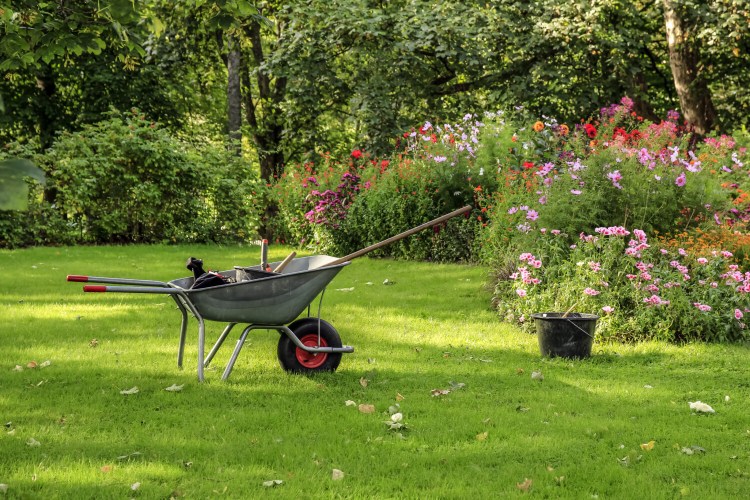The idyllic picture of gardening involves putting in seeds and seedlings with the joyful expectation of the also enjoyable tasks of harvesting or otherwise enjoying those crops in the future.
In reality, much of our time in gardens is spent hauling stuff around: leaves and end-of-the-season cuttings to the compost bins, compost to the garden, mulch to the newly planted ornamental beds and produce to the house.
Those tasks are a lot simpler for people who have the proper tools. And by proper, I mean tools that meet the needs of the specific gardener.
For example, my favorite piece of equipment for moving compost, mulch, soil and many other things is the old-fashioned one-wheel wheelbarrow. I like it because it is highly maneuverable, easily fitting between rows in the vegetable garden and plants in the flower beds.
After spending too many hours in my younger life trying to keep air in inflatable tires, for the past couple of decades we have purchased wheelbarrows with tires that won’t go flat. They cost a bit more, but the time saved makes the expense worthwhile.
A one-wheel wheelbarrow has disadvantages. It is somewhat unstable and can tip over if you hit an unexpected hole in the ground or let your attention wander for a second.
There will come a time – and I am hoping that it is several years away – that I will have to switch to equipment that is less maneuverable but more stable and requiring less strength. I have been checking out some four-wheel garden carts that will carry as much, if not more, than the wheelbarrow. The loading bed can be tipped so one end lies flat on the ground, which makes it easier to load and unload material. These garden carts have poly tubs and look sturdy, but I haven’t actually tested any of them yet.
For leaf-raking, my favorite tool is as simple as it gets, with handy accessories. It’s the garden tarp. The problem with tarps is that wind always seems to be blowing when we are raking leaves, so the tarp won’t stay in one place.
A few years ago, my wife, Nancy – who does most of the family shopping – found a product called Stakeholder that attaches to the half-inch grommets at the four corners to the tarp. A point holds the tarp in the ground at each corner while we load leaves. Once the tarp is full, the four corners can be attached to each other, and the entire load can be hauled to the compost area using just one hand. The Connecticut manufacturer of the product recommends using 5-by-7-foot tarps because they are easier to handle. So far, I have been using larger tarps, about 8 by 10 feet, with no problems. But as I get older and weaker, I expect to switch to the smaller size.
We used to have a larger wooden garden cart with bicycle wheels, but as it got battered, we gave it up and didn’t replace it. Storing it took up too much space in the garage for the few times we used it. But for people with more storage space who have to haul firewood, for example, it might be a good addition.
Those are the hard-work haulers. Now for the fun stuff – bringing in the harvest.
One popular Maine-made product is Pikes Garden Hod, made by Maine Garden Products in Howland. It is designed after clam hods – hardwood at the ends with vinyl-covered (lobster trap-style) wire in between – and has the advantage of letting gardeners rinse off vegetables before bringing them indoors. It also is attractive enough to be put on display throughout the house.
Another popular hauler is the 5-gallon pail. We have dozens. You can buy them at any hardware store, but most of ours once held everything from driveway sealer to bulk amounts of cake frosting. You need to keep your eyes open and be willing to pick up pails beside the road, at the dump and, infrequently, during the big-item pick-up in some towns once a year.
We use them when we are picking up acorns that we don’t want in with the leaves we are composting – and there have been a lot this year. We also use them all summer when weeding or at the end of the season cutting back perennials.
It’s easy to carry two at a time to the compost or, if we are talking about cut flowers, to the house. Sometimes I use them to carry water from our rain barrels to dump onto newly planted trees or shrubs so I don’t have to stand with a hose in my hand for half an hour.
While the pails are plastic, which we try to avoid, we have never purchased any. We are making use of something that has already served its intended purpose and would otherwise end up in the trash. Avoiding that saves our town money and helps the environment. And having a 5-gallon frosting pail has a certain cachet.
Tom Atwell has been writing the Maine Gardener column since 2004. He is a freelance writer gardening in Cape Elizabeth and can be contacted at 767-2297 or at:
tomatwell@me.com
Send questions/comments to the editors.



Comments are no longer available on this story